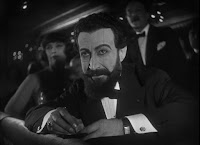Well now… this was a slow-cooked pot-boiler with two hours
and ten minutes of gently simmered passion play, expertly filmed and performed,
especially by the extraordinary Olga Tschechowa, and all filled out by Meg Morley’s
improvisations in heart-rending minor keys. The challenge was not so much the
sheer amount of ground to cover musically but the pace at which things happened
and Meg took it all in her stride from massed showgirls on stage to life or
death car chases and hearts breaking in slow-motion – almost eternal triangles.
It was a perfectly pitched performance and the extended applause from a packed
Bioscope was as much for Meg as the film; a cracking end of year show.
Michelle Facey introduced us to the main players behind
the scene with her trademark thoroughness and penchant for juicy titbits; I
knew that Olga Tschechowa had known Adolf Hitler but what I didn’t know was
that she was a Russian spy tasked with his murder. Based on her display in this
film, she looks more than capable with a fearless performance both as a dancer
on stage and also in terms of her ferocity. She commits to every dark turn and
not in a melodramatic way but with convincing passion.
 |
| Olga Tschechowa |
Ewald André Dupont – director of The Ancient Law
(1923) and Variety (1925) - wrote, produced and directed with his debut
film in Britain and brought his ability to capture performance especially in
the long opening section showing acts at Paris' grand Casino de Paris standing in for
the Moulin Rouge – it’s a full 27 minutes before we really get to the characters
interacting. The film's detailed scenes was shot in Elstree but there are plenty of exterior night shots
showing the illuminated locations in Paris and the interiors shots show thoroughbred comtemporary performers in the Casino.
Dupont sets the scene so well with so many mini dramas, a man trying to decide between two prostitutes, another selling dirty postcards, the audience watching the show and each other and the spectacular acts on stage. If nothing else, Mouline Rouge is a superb snapshot of French musical hall entertainment featuring so many acts - dancers, actors, singers and snake charmers who otherwise would only be found on palybills and mentioned in reviews.
 |
| Un-named cabaret contortionist |
Tschechowa stars as Parysia the main attraction at
the Moulin’s cabaret and one can easily see why in her eye-popping costume and
with her natural poise on stage during so many West End professionals. She has
a daughter, Margaret, played by Eve Gray who had a short role as a murderee in The
Lodger and she’s not the only one from that film as an uncredited Marie
Ault turns up late in the film as a backstage helper trying to restrain an
hysterical Parysia.
Margaret has been away at expensive finishing school and
turns up to see her mother perform after four years away. With her is Andre (Frenchman,
Jean Bradin, who was in Prix de Beauty with Louise Brooks) the son of a
wealthy father (Georges Tréville) who, naturally does not approve of the
relationship given her mother’s career.
 |
| Watching Mother on stage: Jean Bradin and Eve Gray |
Andre is immediately star-struck and buys a programme
featuring lots of pics of his girlfriend’s Mum, for a man about to marry his love he does
seem easily distracted by Parysia’s more overt sexual presence but he falls
hard and the complications begin.
As Michelle pointed out, Gray was only three years
younger than Tschechowa, but the two make the relationship believable even
though Olga was only 31, she carries it off and there’s one memorable scene in
which, face covered with cream she stares horrified at her aging face in the
mirror… that’s acting my dears! Dupont juxtaposes this with Andre lying in bed
and reading the programme he bought, lusting after her provocative photographs
just as she doubts her aging appeal and giving, quite possibly, a whole new meaning
to the phrase jazz-age mags.
  |
| What the face cream won't hide and Andre's magazine heaven |
 |
| Andre reveals his true feelings... |
It was a smashing end to the year for the Bioscope and another
film that shows the strength of British silent film, especially when it
collaborated with European talent. It was enlivened by Meg Morley's superb musicianship; she has a real feel for jazz-age narratives and played tirelessly for this Moulin Marathon!
 |
| Cheats! There's 38 of you and Meg did it all on her own! |
And now for a visual postscript for your delectation...



































No comments:
Post a Comment